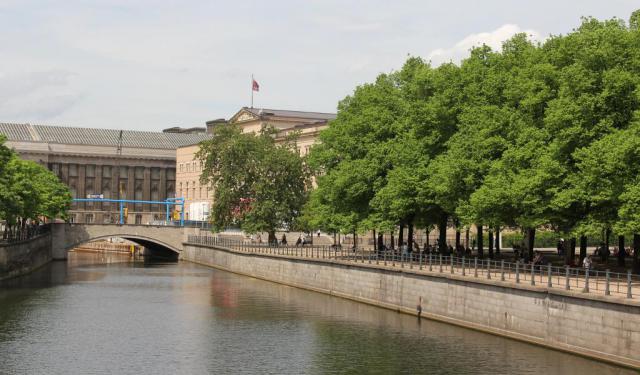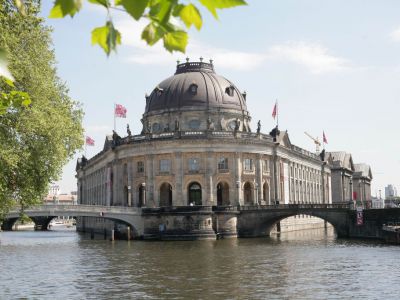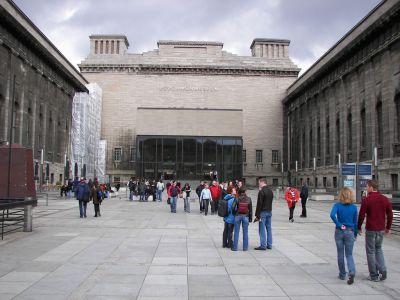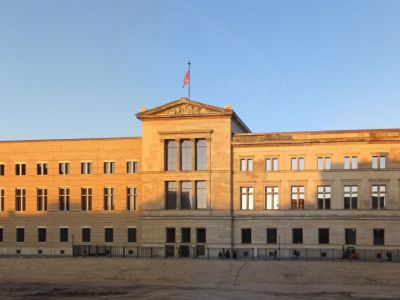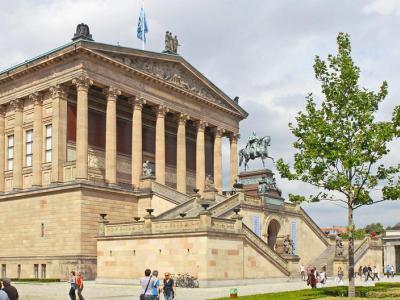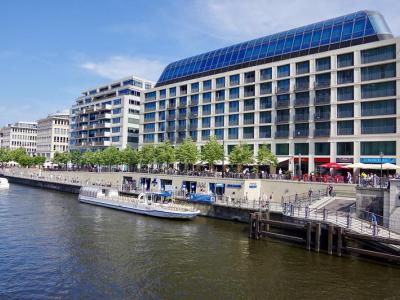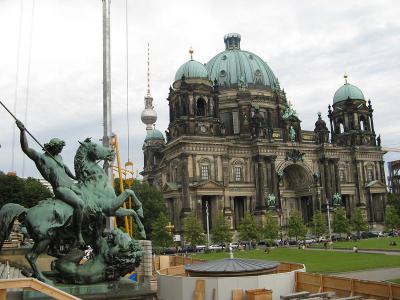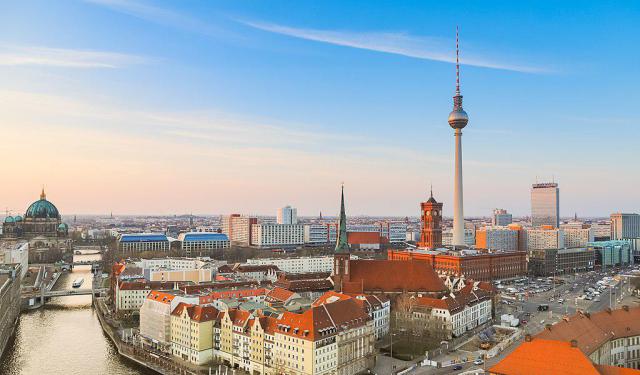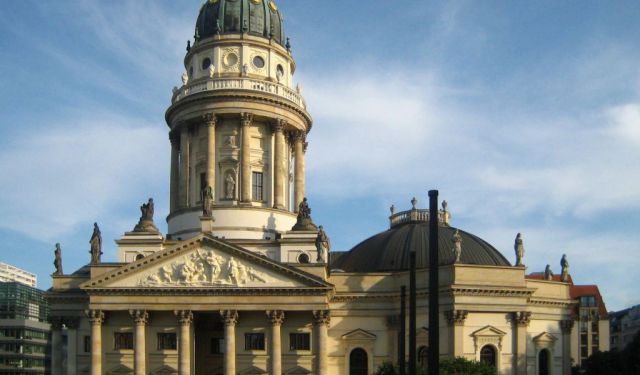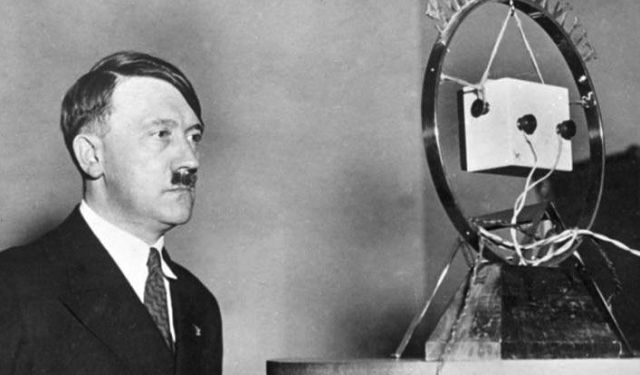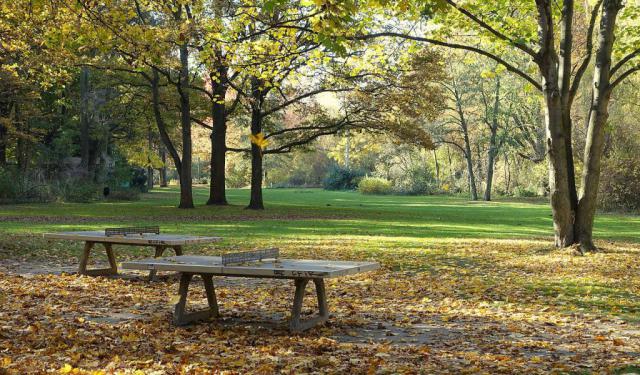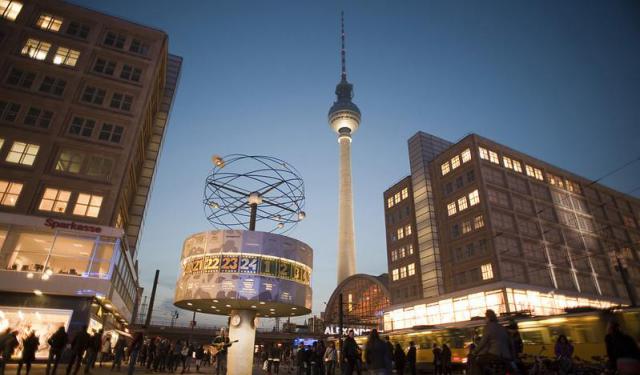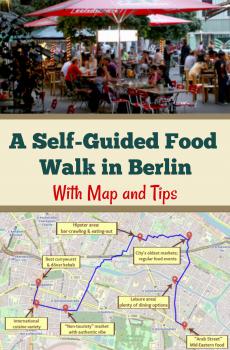Audio Guide: Museum Island Walking Tour (Self Guided), Berlin
Welcome to Museum Island-the grand project of King Frederick William IV of Prussia, implemented in the mid-19th century (probably “to impress future tourists”). The whole concept kicked off with the Old Museum-a true gem for the Greco-Roman classics fans, designed by the superstar architect Karl Friedrich Schinkel in 1830. The idea was to make art and knowledge accessible to the public. The Prussian royals figured it was high time culture stopped being a private collection thing and became more of a community affair.
Over the years, more museums popped up, forming this cultural pentagon of awe. Indeed, today, this little slice of cultural paradise in the heart of Berlin packs a punch with not just one or two but a whole lineup of world-famous museums practically holding hands.
But before you storm these gates of knowledge, here’s a smart traveler tip: Each museum charges a modest fee. But if you're the kind who likes to binge-watch civilizations, do yourself a favor and grab the 3-day pass. It's good value for money.
The best place to snag it is the Bode Museum-that charming beauty at the northern tip of the island. It specializes in Byzantine art, medieval sculptures, and a coin collection that spans millennia. Also, the on-site café is classy enough to make you understand what Rococo really means.
Whenever you're ready for the heavy hitters, proceed to the Pergamon and the New Museum, where ancient civilizations show off their greatest hits. For Pergamon, one word is “massive.” Inside, it's got actual buildings from ancient Babylon, Greece, and Rome. Not models-real stone-by-stone reconstructions like the Pergamon Altar and the Ishtar Gate. Your jaw may drop. Repeatedly.
As for the New Museum, it's a truly dramatic comeback kid. Bombed in World War II and left in ruins for decades, it was gorgeously restored by British architect David Chipperfield. Inside, you'll find Egyptian and prehistoric collections, including Berlin’s biggest diva-Queen Nefertiti herself. Yes, the bust. But let’s be honest: She still outshines many modern beauties in the eyeliner department.
And if you're craving a little architectural grandeur with your history lesson, check out the Berlin Cathedral. Built in the 19th century during the Kaiser era, this stunner is as over-the-top as a royal family holiday card.
So there you have it-a cultural jackpot nestled on an island. Don’t skip it. Walk it, wander it, and wonder at it. Museum Island isn’t just Berlin’s must-see-it’s your all-access pass to time travel, without the jet lag.
Over the years, more museums popped up, forming this cultural pentagon of awe. Indeed, today, this little slice of cultural paradise in the heart of Berlin packs a punch with not just one or two but a whole lineup of world-famous museums practically holding hands.
But before you storm these gates of knowledge, here’s a smart traveler tip: Each museum charges a modest fee. But if you're the kind who likes to binge-watch civilizations, do yourself a favor and grab the 3-day pass. It's good value for money.
The best place to snag it is the Bode Museum-that charming beauty at the northern tip of the island. It specializes in Byzantine art, medieval sculptures, and a coin collection that spans millennia. Also, the on-site café is classy enough to make you understand what Rococo really means.
Whenever you're ready for the heavy hitters, proceed to the Pergamon and the New Museum, where ancient civilizations show off their greatest hits. For Pergamon, one word is “massive.” Inside, it's got actual buildings from ancient Babylon, Greece, and Rome. Not models-real stone-by-stone reconstructions like the Pergamon Altar and the Ishtar Gate. Your jaw may drop. Repeatedly.
As for the New Museum, it's a truly dramatic comeback kid. Bombed in World War II and left in ruins for decades, it was gorgeously restored by British architect David Chipperfield. Inside, you'll find Egyptian and prehistoric collections, including Berlin’s biggest diva-Queen Nefertiti herself. Yes, the bust. But let’s be honest: She still outshines many modern beauties in the eyeliner department.
And if you're craving a little architectural grandeur with your history lesson, check out the Berlin Cathedral. Built in the 19th century during the Kaiser era, this stunner is as over-the-top as a royal family holiday card.
So there you have it-a cultural jackpot nestled on an island. Don’t skip it. Walk it, wander it, and wonder at it. Museum Island isn’t just Berlin’s must-see-it’s your all-access pass to time travel, without the jet lag.
How it works: Download the app "GPSmyCity: Walks in 1K+ Cities" from Apple App Store or Google Play Store to your mobile phone or tablet. The app turns your mobile device into a personal tour guide and its built-in GPS navigation functions guide you from one tour stop to next. The app works offline, so no data plan is needed when traveling abroad.
Museum Island Walking Tour Map
Guide Name: Museum Island Walking Tour
Guide Location: Germany » Berlin (See other walking tours in Berlin)
Guide Type: Self-guided Walking Tour (Sightseeing)
# of Attractions: 7
Tour Duration: 1 Hour(s)
Travel Distance: 1.2 Km or 0.7 Miles
Author: derek
Sight(s) Featured in This Guide:
Guide Location: Germany » Berlin (See other walking tours in Berlin)
Guide Type: Self-guided Walking Tour (Sightseeing)
# of Attractions: 7
Tour Duration: 1 Hour(s)
Travel Distance: 1.2 Km or 0.7 Miles
Author: derek
Sight(s) Featured in This Guide:
- Bode-Museum
- Pergamon Museum
- Neues Museum (New Museum)
- Altes Museum (Old Museum)
- Alte Nationalgalerie (Old National Gallery)
- DDR Museum
- Berliner Dom (Berlin Cathedral)
1) Bode-Museum
Perched proudly at the northern tip of Berlin’s Museum Island-like a swan striking a pose-the Bode Museum stands tall with its show-stopping double dome and regal columns, gracefully hugged on two sides by the Spree River. Sure, the outside is impressive enough, but step inside, and you’re in for a proper architectural flex: sweeping staircases, sky-high ceilings, and classical features creating the perfect backdrop for museum exploration.
Now, speaking of art-the Bode isn’t just pretty; it’s stacked. This place holds one of the largest sculpture collections on the planet. From early medieval marvels to late 18th-century elegance, you’ll find a European roll call of artistry. Among the standouts, check out glazed terracotta beauties from the Italian Renaissance and a few wooden wonders by 16th-century German sculptor Tilman Riemenschneider that absolutely steal the limelight. Seriously, a wooden sculpture has never looked this good.
But there’s more. If Byzantine art makes your heart flutter, prepare yourself: over 150 works spanning a whopping 12 centuries. Among them, the coin cabinet- a treasure trove of Byzantine coins and medals that would make any history buff giddy. Plus, there’s an entire section devoted to Orthodox Christian art from Greece, the Balkans, Russia, and even North Africa-iconic in every sense of the word.
Need a breather between cultural deep-dives? The museum café’s got your back, serving caffeine and cake with a side of Baroque glamour. And if you feel the urge to bring a bit of Bode home (because you might), there’s a cozy little gift shop tucked in the back with books, souvenirs, and more temptations than can push your luggage allowance to the limit.
Tip:
Bags get checked at the door, but your camera’s totally invited. Snap to your heart’s content.
And for the savvy museum-hopper, the 3-day Museum Pass is your golden ticket-it’s budget-friendly and lets you glide through the rest of Museum Island like a seasoned pro.
Now, speaking of art-the Bode isn’t just pretty; it’s stacked. This place holds one of the largest sculpture collections on the planet. From early medieval marvels to late 18th-century elegance, you’ll find a European roll call of artistry. Among the standouts, check out glazed terracotta beauties from the Italian Renaissance and a few wooden wonders by 16th-century German sculptor Tilman Riemenschneider that absolutely steal the limelight. Seriously, a wooden sculpture has never looked this good.
But there’s more. If Byzantine art makes your heart flutter, prepare yourself: over 150 works spanning a whopping 12 centuries. Among them, the coin cabinet- a treasure trove of Byzantine coins and medals that would make any history buff giddy. Plus, there’s an entire section devoted to Orthodox Christian art from Greece, the Balkans, Russia, and even North Africa-iconic in every sense of the word.
Need a breather between cultural deep-dives? The museum café’s got your back, serving caffeine and cake with a side of Baroque glamour. And if you feel the urge to bring a bit of Bode home (because you might), there’s a cozy little gift shop tucked in the back with books, souvenirs, and more temptations than can push your luggage allowance to the limit.
Tip:
Bags get checked at the door, but your camera’s totally invited. Snap to your heart’s content.
And for the savvy museum-hopper, the 3-day Museum Pass is your golden ticket-it’s budget-friendly and lets you glide through the rest of Museum Island like a seasoned pro.
2) Pergamon Museum (must see)
Now, this museum doesn’t just collect history-it reconstructs it, brick by ancient brick... With its crown jewel none other than the mighty Pergamon Zeus Altar (dating back to the 2nd century BC), this place is basically Europe’s VIP lounge for antiquities. Yes, it’s as jaw-dropping as it sounds, with life-sized architectural stunners casually sitting around like it’s no big deal.
Even if partially open, as during the scheduled makeover set to finish by 2026, this museum still has plenty to offer. Seeing everything it has in one go is a full-on epic quest, so bringing snacks is highly recommended.
The museum splits its magic into three power-packed sections. First, the star attraction: the Classical Antiquities Collection. Now, this isn’t just broken pottery and dusty statues. We’re talking the full Gate of Miletus, the legendary Pergamon Altar, and enough Greco-Roman artifacts to make an emperor jealous.
Then there’s the Islamic Art Museum and the Ancient Near East Museum. Picture the 8th-century castle facade from Jordan, the radiant blue Ishtar Gate, and the Babylonian Processional Way-basically ancient urban planning with flair. Add to it some of humanity’s earliest scribbles, delicate ceramics, ancient carpets, and even decorative windows, and you've got yourself a museum buffet.
And just when you think you’ve seen it all-surprise!-there’s the Pergamon Panorama, a separate bonus round just five minutes away on foot. Multi-level, immersive, and totally wild, it’s included in your ticket and might just make your inner history nerd do a happy dance.
Pro tip before you go: Skip the ticket line drama and book online with a time slot. You'll waltz right in like a VIP. And don’t forget the free audio guide-because decoding ancient marvels is way more fun when you’ve got an expert in your ear.
Even if partially open, as during the scheduled makeover set to finish by 2026, this museum still has plenty to offer. Seeing everything it has in one go is a full-on epic quest, so bringing snacks is highly recommended.
The museum splits its magic into three power-packed sections. First, the star attraction: the Classical Antiquities Collection. Now, this isn’t just broken pottery and dusty statues. We’re talking the full Gate of Miletus, the legendary Pergamon Altar, and enough Greco-Roman artifacts to make an emperor jealous.
Then there’s the Islamic Art Museum and the Ancient Near East Museum. Picture the 8th-century castle facade from Jordan, the radiant blue Ishtar Gate, and the Babylonian Processional Way-basically ancient urban planning with flair. Add to it some of humanity’s earliest scribbles, delicate ceramics, ancient carpets, and even decorative windows, and you've got yourself a museum buffet.
And just when you think you’ve seen it all-surprise!-there’s the Pergamon Panorama, a separate bonus round just five minutes away on foot. Multi-level, immersive, and totally wild, it’s included in your ticket and might just make your inner history nerd do a happy dance.
Pro tip before you go: Skip the ticket line drama and book online with a time slot. You'll waltz right in like a VIP. And don’t forget the free audio guide-because decoding ancient marvels is way more fun when you’ve got an expert in your ear.
3) Neues Museum (New Museum) (must see)
The crown jewel of Museum Island-the New Museum-has been back in action since 2009 and just begging for a deep dive. Not a literal one, of course-security frowns on that. We’re talking about four glorious floors packed with Berlin’s finest archaeological bling. Think global, think ancient, think seriously impressive: from prehistoric bits and bobs to full-on cultural blockbusters-Greeks, Romans, Nubians, and, of course, the ever-iconic Egyptians.
Now, speaking of the Egyptians-yes, the Nefertiti is here! She’s flawless. She’s got cheekbones that could cut glass and a gaze that’s been melting hearts for over 3,000 years. Believe it-you’ll want to admire her from every possible angle. (And no, sadly, selfies are not allowed.)
But don’t stop there-this place is full of surprises. One room even lets you summon ancient papyrus scrolls with the press of a button. It’s like Indiana Jones meets touchscreen tech. Keep an eye out for info cards, too-they’ll tell you which treasures survived World War II unscathed and which ones had a bit of reconstructive “tender loving care.”
On the second floor, there’s more Egyptian art to devour, and one level down is a temple. A whole courtyard. Basically, your inner explorer will be doing cartwheels.
And don’t even think about breezing past the Bronze and Iron Age exhibits. They’re not just pots and pointy sticks-these are ancient multitools, weapons, and mystical relics, served up with excavation pics and diagrams that make you feel like you’re right there in the dirt.
Oh, and then there’s the Golden Hat. Sounds fancy, right? It is. Shiny, mysterious, and probably used to predict eclipses, rule tribes, or host very exclusive dinner parties-no one’s entirely sure.
And if that doesn't impress you much, let the Berlin Green Head, a freakishly lifelike sculpture, stare into your soul. Or wander through rooms of mummies, sarcophagi, treasures from Troy, Nordic myth murals, and tiny blue animal-shaped faience from ancient tombs. It’s basically a time-traveling greatest-hits album.
Tip:
Arrive early. Really early. This place gets busy. A Berlin Card or museum pass will save your wallet and your patience. And when you enter, don’t go rogue-start at the top floor and descend like an archaeological royalty. An audio guide or tour is optional but highly recommended for full nerd-out potential.
Now, speaking of the Egyptians-yes, the Nefertiti is here! She’s flawless. She’s got cheekbones that could cut glass and a gaze that’s been melting hearts for over 3,000 years. Believe it-you’ll want to admire her from every possible angle. (And no, sadly, selfies are not allowed.)
But don’t stop there-this place is full of surprises. One room even lets you summon ancient papyrus scrolls with the press of a button. It’s like Indiana Jones meets touchscreen tech. Keep an eye out for info cards, too-they’ll tell you which treasures survived World War II unscathed and which ones had a bit of reconstructive “tender loving care.”
On the second floor, there’s more Egyptian art to devour, and one level down is a temple. A whole courtyard. Basically, your inner explorer will be doing cartwheels.
And don’t even think about breezing past the Bronze and Iron Age exhibits. They’re not just pots and pointy sticks-these are ancient multitools, weapons, and mystical relics, served up with excavation pics and diagrams that make you feel like you’re right there in the dirt.
Oh, and then there’s the Golden Hat. Sounds fancy, right? It is. Shiny, mysterious, and probably used to predict eclipses, rule tribes, or host very exclusive dinner parties-no one’s entirely sure.
And if that doesn't impress you much, let the Berlin Green Head, a freakishly lifelike sculpture, stare into your soul. Or wander through rooms of mummies, sarcophagi, treasures from Troy, Nordic myth murals, and tiny blue animal-shaped faience from ancient tombs. It’s basically a time-traveling greatest-hits album.
Tip:
Arrive early. Really early. This place gets busy. A Berlin Card or museum pass will save your wallet and your patience. And when you enter, don’t go rogue-start at the top floor and descend like an archaeological royalty. An audio guide or tour is optional but highly recommended for full nerd-out potential.
4) Altes Museum (Old Museum)
The Old Museum is indeed old-Born in 1830, back when top hats were serious business and museums weren’t just art-filled afterthoughts. This was the first purpose-built museum in Prussia-because when the royal family needed a place for their prized collection, they didn’t settle for a spare room. No, they went full neoclassical drama right on the riverbank. Columns, grandeur-all here. Great lawn for lounging and Instagram shots? You bet.
Inside, expectations run high-and rightfully so. The ancient Greek collection doesn’t just show up; it performs. You’ve got exquisite vases, expertly chiseled gods, and statues so lifelike you’ll expect them to stretch mid-pose. Look out for the bronze “Praying Boy” (he’s adorable), the mysterious “Berlin Goddess,” and athletes frozen in eternal flex.
The southern Italian Greek colonies section turns up the volume with oversized pottery that says, “Go big or go back to the mainland.”
Upstairs, the Etruscans make an appearance-mainly through grave goods and reliefs because, apparently, they really knew how to decorate for the afterlife. But the Romans-they really steal the spotlight. Think grand sarcophagi, towering statues, and enough busts to make a history professor weep. Yes, Caesar and Cleopatra are here too, immortalized in marble like the true drama magnets they were.
However, what really makes this museum stand out is not just the artifacts but how immaculately they’re preserved and clearly explained. It's like the collection comes with its own historical subtitles.
Tip:
Don’t skip the second floor-temporary exhibits pop up there now and then, and they’re often just as spectacular as the permanent residents.
Inside, expectations run high-and rightfully so. The ancient Greek collection doesn’t just show up; it performs. You’ve got exquisite vases, expertly chiseled gods, and statues so lifelike you’ll expect them to stretch mid-pose. Look out for the bronze “Praying Boy” (he’s adorable), the mysterious “Berlin Goddess,” and athletes frozen in eternal flex.
The southern Italian Greek colonies section turns up the volume with oversized pottery that says, “Go big or go back to the mainland.”
Upstairs, the Etruscans make an appearance-mainly through grave goods and reliefs because, apparently, they really knew how to decorate for the afterlife. But the Romans-they really steal the spotlight. Think grand sarcophagi, towering statues, and enough busts to make a history professor weep. Yes, Caesar and Cleopatra are here too, immortalized in marble like the true drama magnets they were.
However, what really makes this museum stand out is not just the artifacts but how immaculately they’re preserved and clearly explained. It's like the collection comes with its own historical subtitles.
Tip:
Don’t skip the second floor-temporary exhibits pop up there now and then, and they’re often just as spectacular as the permanent residents.
5) Alte Nationalgalerie (Old National Gallery)
The Old National Gallery is Berlin’s answer to the question: “What if a palace married a paintbrush?” More than just a pretty face, this place is a cultural heavyweight with a dramatic backstory and columns doing their best impression of an ancient Greek temple. Opened in 1876 and perched proudly on Museum Island-a UNESCO World Heritage Site-this cultural gem looks like it should house philosophers in togas, but instead greets you with King Friedrich Wilhelm IV on horseback and a lot of serious staircases.
Originally built to showcase the glory of Prussian art, the gallery has since expanded into a full-blown tour through European painting and sculpture, covering everything from 18th-century powdered wigs to early 20th-century existential crises. It flaunts a knockout collection of art that gallops through the crisp elegance of Neoclassicism, tiptoes the dreamlike drama of German Romanticism, flirts with Impressionism, and dips its toes into early Modernism. You name it, it's on the wall somewhere.
One of the show-stoppers is the moody, misty masterpieces of Caspar David Friedrich. His “Monk by the Sea” painting might just be the world’s most poetic take on a beach day-lonely, windswept, and begging to be over-analyzed. But don’t stop there. The gallery is packed with under-the-radar treasures from lesser-known artists that’ll have you muttering, “How come I never heard of this genius?”
Need a little light after all that brooding Romanticism? Head to the French Impressionist section, where the light-drenched works of the likes of Monet, Manet, Renoir, and Pissarro dial up the color-and the charm. And let’s not forget the home team: German Impressionist Max Liebermann leads a vibrant charge with brushstrokes that shimmer and settings that hum with life.
But what really sets the Old National Gallery apart is not just the art-it’s the vibe. The layout flows like a well-paced playlist, and there’s plenty of space to breathe, stroll, and silently judge other people’s taste in art. Add in those elegant interiors and the ever-so-helpful audio guides, and you’ve got a recipe for a museum visit that’s equal parts inspiring and Insta-worthy.
So whether you’re a seasoned art snob or just here for a cultured detour between currywurst breaks, the Old National Gallery delivers the goods-with a side of grandeur.
Tip:
Grab the free headset. It’s packed with juicy insights, especially on German painters, and it makes you look like you really know what you're doing.
Originally built to showcase the glory of Prussian art, the gallery has since expanded into a full-blown tour through European painting and sculpture, covering everything from 18th-century powdered wigs to early 20th-century existential crises. It flaunts a knockout collection of art that gallops through the crisp elegance of Neoclassicism, tiptoes the dreamlike drama of German Romanticism, flirts with Impressionism, and dips its toes into early Modernism. You name it, it's on the wall somewhere.
One of the show-stoppers is the moody, misty masterpieces of Caspar David Friedrich. His “Monk by the Sea” painting might just be the world’s most poetic take on a beach day-lonely, windswept, and begging to be over-analyzed. But don’t stop there. The gallery is packed with under-the-radar treasures from lesser-known artists that’ll have you muttering, “How come I never heard of this genius?”
Need a little light after all that brooding Romanticism? Head to the French Impressionist section, where the light-drenched works of the likes of Monet, Manet, Renoir, and Pissarro dial up the color-and the charm. And let’s not forget the home team: German Impressionist Max Liebermann leads a vibrant charge with brushstrokes that shimmer and settings that hum with life.
But what really sets the Old National Gallery apart is not just the art-it’s the vibe. The layout flows like a well-paced playlist, and there’s plenty of space to breathe, stroll, and silently judge other people’s taste in art. Add in those elegant interiors and the ever-so-helpful audio guides, and you’ve got a recipe for a museum visit that’s equal parts inspiring and Insta-worthy.
So whether you’re a seasoned art snob or just here for a cultured detour between currywurst breaks, the Old National Gallery delivers the goods-with a side of grandeur.
Tip:
Grab the free headset. It’s packed with juicy insights, especially on German painters, and it makes you look like you really know what you're doing.
6) DDR Museum
If you’ve ever wondered what life was really like behind the Iron Curtain-minus the Cold War clichés and spy movie melodrama-then the DDR Museum in Berlin is your time machine.
Situated directly across from the Berlin Cathedral, this museum has been in place since 2006. It was the brainchild of ethnologist Peter Kenzelmann, who noticed a lack of exhibits focusing on daily life in the German Democratic Republic (aka East Germany). So he created one.
Under the sharp eye of director historian Dr. Stephan Wolle, this place was designed to skip the propaganda and get real-serving up a mix of hard facts and personal stories, all without turning into a dusty old lecture hall.
Inside, everything’s grouped into categories like “Public Life,” “Life in a Tower Block,” and “State and Ideology,” which basically means: yes, you’ll learn stuff, but you won’t fall asleep doing it. The permanent exhibition is split into 16 themes, such as housing, work, fashion, education, and surveillance. Of particular interest is a full-on WBS 70 (typical East German tower block) apartment replica. It’s got the orange-brown wallpaper, the clunky TV, and that unmistakable scent of... socialist pragmatism.
You can also hop into a Trabant without waiting ten years for a government-issued permit. Well, it's a driving simulator, but who cares-because nothing says "road trip" like a plastic car that tops out at 60 mph.
And this isn’t some average look-but-don’t-touch museum. Nope, it’s fully interactive. That means you get to press the buttons, open the drawers, play dress-up with digital mirrors, and even sit through a simulated Stasi interrogation-just for kicks.
The DDR Museum is open every day from 9 AM to 9 PM, so whether you’re an early bird or a night owl, you’ve got time to drop by. Tickets? At the door or online-your choice.
So why go? Because history here isn’t under glass-it’s under your fingertips. And if your curiosity for Cold War kitsch isn’t quite satisfied, swing by the Stasimuseum for more spy vibes, then hit the AMPELMANN store nearby, where East Germany’s most cheerful legacy-those charming crosswalk figures-lives on as tote bags, keychains, and questionable fashion choices.
Situated directly across from the Berlin Cathedral, this museum has been in place since 2006. It was the brainchild of ethnologist Peter Kenzelmann, who noticed a lack of exhibits focusing on daily life in the German Democratic Republic (aka East Germany). So he created one.
Under the sharp eye of director historian Dr. Stephan Wolle, this place was designed to skip the propaganda and get real-serving up a mix of hard facts and personal stories, all without turning into a dusty old lecture hall.
Inside, everything’s grouped into categories like “Public Life,” “Life in a Tower Block,” and “State and Ideology,” which basically means: yes, you’ll learn stuff, but you won’t fall asleep doing it. The permanent exhibition is split into 16 themes, such as housing, work, fashion, education, and surveillance. Of particular interest is a full-on WBS 70 (typical East German tower block) apartment replica. It’s got the orange-brown wallpaper, the clunky TV, and that unmistakable scent of... socialist pragmatism.
You can also hop into a Trabant without waiting ten years for a government-issued permit. Well, it's a driving simulator, but who cares-because nothing says "road trip" like a plastic car that tops out at 60 mph.
And this isn’t some average look-but-don’t-touch museum. Nope, it’s fully interactive. That means you get to press the buttons, open the drawers, play dress-up with digital mirrors, and even sit through a simulated Stasi interrogation-just for kicks.
The DDR Museum is open every day from 9 AM to 9 PM, so whether you’re an early bird or a night owl, you’ve got time to drop by. Tickets? At the door or online-your choice.
So why go? Because history here isn’t under glass-it’s under your fingertips. And if your curiosity for Cold War kitsch isn’t quite satisfied, swing by the Stasimuseum for more spy vibes, then hit the AMPELMANN store nearby, where East Germany’s most cheerful legacy-those charming crosswalk figures-lives on as tote bags, keychains, and questionable fashion choices.
7) Berliner Dom (Berlin Cathedral) (must see)
Despite what its lofty name suggests, the Berlin Cathedral is... not a cathedral. Yep, never was. Because Berlin never had a Catholic bishop in the house.
Now, rewind to 1451, when Prince-Elector Frederick II-nicknamed "Iron-tooth" because, well, medieval PR was wild-built a castle chapel right here. It started out Catholic, then switched to Lutheran in 1539, and just to keep things spicy, went Calvinist by 1608.
The version we see today is a Neo-Renaissance stunner, built between 1894 and 1905 by order of Emperor Wilhelm II, who basically wanted his very own Protestant answer to the Vatican’s Saint Peter’s Basilica. And what a power move it was: 114 meters long, 73 wide, and 116 tall-this place made everything else in Berlin look like dollhouse furniture.
And it wasn’t just for show, either. The Hohenzollerns-Germany’s royal family-worshipped here and even used the crypt as their final resting place. That lasted until 1918, when Wilhelm II peaced out to the Netherlands after abdicating the throne.
Then came World War II, and let’s just say the cathedral did not come out looking its best. East Germany did some repairs-thanks, GDR-but also tore down the Memorial Church in 1975, which wasn’t their finest hour.
Fast forward to 1993, and voilà: the place got a full glow-up. It now has the majestic pipe organ, pristine acoustics, priceless art, and vibes so divine they practically echo. Today, it’s home to choirs galore, including the English Choir Berlin, which hosts monthly Choral Evensong in true Anglican style.
If you're feeling brave, you can climb the dome! There’s a roomy stairwell, plenty of landings to catch your breath-and yes, actual chairs if you need a moment. At the bottom, history buffs rejoice: the crypt holds 94 royal sarcophagi. It's like Prussian Netflix, but... quieter.
Tip:
Snag the audio guide-it’s a small fee for a big info boost. Or grab a printed guide if you're old school. And in the summer, feel free to stretch out on the lawn across the street, near the fountain. It's the perfect picnic spot, and the cathedral makes a dramatic lunch backdrop.
Now, rewind to 1451, when Prince-Elector Frederick II-nicknamed "Iron-tooth" because, well, medieval PR was wild-built a castle chapel right here. It started out Catholic, then switched to Lutheran in 1539, and just to keep things spicy, went Calvinist by 1608.
The version we see today is a Neo-Renaissance stunner, built between 1894 and 1905 by order of Emperor Wilhelm II, who basically wanted his very own Protestant answer to the Vatican’s Saint Peter’s Basilica. And what a power move it was: 114 meters long, 73 wide, and 116 tall-this place made everything else in Berlin look like dollhouse furniture.
And it wasn’t just for show, either. The Hohenzollerns-Germany’s royal family-worshipped here and even used the crypt as their final resting place. That lasted until 1918, when Wilhelm II peaced out to the Netherlands after abdicating the throne.
Then came World War II, and let’s just say the cathedral did not come out looking its best. East Germany did some repairs-thanks, GDR-but also tore down the Memorial Church in 1975, which wasn’t their finest hour.
Fast forward to 1993, and voilà: the place got a full glow-up. It now has the majestic pipe organ, pristine acoustics, priceless art, and vibes so divine they practically echo. Today, it’s home to choirs galore, including the English Choir Berlin, which hosts monthly Choral Evensong in true Anglican style.
If you're feeling brave, you can climb the dome! There’s a roomy stairwell, plenty of landings to catch your breath-and yes, actual chairs if you need a moment. At the bottom, history buffs rejoice: the crypt holds 94 royal sarcophagi. It's like Prussian Netflix, but... quieter.
Tip:
Snag the audio guide-it’s a small fee for a big info boost. Or grab a printed guide if you're old school. And in the summer, feel free to stretch out on the lawn across the street, near the fountain. It's the perfect picnic spot, and the cathedral makes a dramatic lunch backdrop.
Walking Tours in Berlin, Germany
Create Your Own Walk in Berlin
Creating your own self-guided walk in Berlin is easy and fun. Choose the city attractions that you want to see and a walk route map will be created just for you. You can even set your hotel as the start point of the walk.
Berlin Introduction Walking Tour
The German capital, Berlin, is known for its turbulent past. Today, this sprawling metropolis is filled with a mix of historical resonance and modernity manifested in creative industries, popular media, and diverse cultural tourism.
The first written records of settlements in the present-day Berlin area date back to the late 12th century. In 1157, the region came under German rule as part of... view more
Tour Duration: 2 Hour(s)
Travel Distance: 4.0 Km or 2.5 Miles
The first written records of settlements in the present-day Berlin area date back to the late 12th century. In 1157, the region came under German rule as part of... view more
Tour Duration: 2 Hour(s)
Travel Distance: 4.0 Km or 2.5 Miles
Berlin's Historical Churches Walking Tour
Berlin boasts a diversity of important religious sights. Among the most acclaimed are the places of worship centuries old, such as the beautiful Neo-Classical style Nikolaikirche or the red-brick Gothic style Marienkirche (St. Mary’s Church), both dating back to the 1200s. Aside from being home to the best organ music in town, Marienkirche’s hall still contains numerous beautiful features and... view more
Tour Duration: 1 Hour(s)
Travel Distance: 2.7 Km or 1.7 Miles
Tour Duration: 1 Hour(s)
Travel Distance: 2.7 Km or 1.7 Miles
Third Reich Walking Tour
Between the years 1933 and 1945, Germany was governed as a totalitarian state under the rule of Adolf Hitler and the National Socialist German Workers’ Party-more widely known as the Nazi Party. This era is commonly referred to as the "Third Reich" or "Nazi Germany."
For those visiting Berlin today, the events surrounding the Nazi regime and its surrender that brought... view more
Tour Duration: 2 Hour(s)
Travel Distance: 4.0 Km or 2.5 Miles
For those visiting Berlin today, the events surrounding the Nazi regime and its surrender that brought... view more
Tour Duration: 2 Hour(s)
Travel Distance: 4.0 Km or 2.5 Miles
Tiergarten Walking Tour
Known for the huge park of the same name, which once was a royal hunting ground, the central district of Tiergarten (German for “Animal Garden”) is home to the Berlin Zoo, the Victory Column with its winged statue and the lively, lakeside Café am Neuen See.
Begin your exploration at Postdamer Platz, the historic central square of Berlin, once regarded in the same way as Piccadilly Circus... view more
Tour Duration: 2 Hour(s)
Travel Distance: 3.4 Km or 2.1 Miles
Begin your exploration at Postdamer Platz, the historic central square of Berlin, once regarded in the same way as Piccadilly Circus... view more
Tour Duration: 2 Hour(s)
Travel Distance: 3.4 Km or 2.1 Miles
Berlin Food Walking Tour
While Berlin may not be considered a typical foodie destination yet, recent years saw a growing number of decent places to eat, serving both German and international cuisine. At some point, the city has even earned itself the title of a vegetarian capital of the world, contrary to what one may have expected. Amid all this renaissance in creativity and culture, coupled with the influx of the... view more
Tour Duration: 1 Hour(s)
Travel Distance: 1.4 Km or 0.9 Miles
Tour Duration: 1 Hour(s)
Travel Distance: 1.4 Km or 0.9 Miles
Alexanderplatz Walking Tour
One of Berlin’s cosmopolitan hearts, Alexanderplatz (or Alexander Square) is a true hive of activity. There is always something going on here: Christmas markets, Easter fairs, buskers, performances, Oktoberfest, and the list is countless. Easily accessible, with lots of transport connections and all manner of drink and food outlets, it’s a great place to hang around, take photos, and enjoy... view more
Tour Duration: 1 Hour(s)
Travel Distance: 1.6 Km or 1 Miles
Tour Duration: 1 Hour(s)
Travel Distance: 1.6 Km or 1 Miles
Useful Travel Guides for Planning Your Trip
Berlin Mementos: 18 Souvenir Shopping Ideas for Travelers
Too many people and for very different reasons strove to set their foot in Berlin over the course of the 20th century. Today, the city proves just as luring a destination for numerous travelers who want to come and enjoy themselves in this fascinating European capital and, perhaps, bring home...
A Self-Guided Food Walk in Berlin
Repeatedly scarred throughout its long and often depressing past, today's Berlin has made a comeback as a major bohemian hub which lures artists and creatively-minded folk from all over the globe in their droves. It may well not be considered a typical foodie destination yet, but in recent...
Best Cafés and Coffee Houses of Berlin
Cafes have a certain refinery and elegance that pubs lack; there is a mellowness that is rarely found in bars and clubs, and an ease and tranquillity that is not to be found in restaurants with their steaming kitchens, heavy plates, clattering cutlery, constant complaints and corrections and,...
Best Cafes in Kreuzberg, Berlin
Traditionally, you may expect the cafes around Kottbusser Tor and throughout Kreuzberg to be dominated by ethnic Turks, particularly men, in rooms that do much to resemble the cafes of Istanbul.
More recently, however, the ethnically Turkish and Arab communities that have typically inhabited...
Best Bars in Kreuzberg, Berlin
Kreuzberg and "Kreuzkölln" - the area where Kreuzberg and Neukölln meet, mostly along the canal in east Kreuzberg and north of Sonnenallée in Neukölln - has a constantly and rapidly evolving bar culture that makes it one of the trendiest alternative evening and nightlife spots in...
Best Food in Kreuzberg, Berlin
Kreuzberg is known for having great cheap, street food, particularly of the Middle Eastern variety. On almost every corner you can find a kebab or falafel shop, although the trick is knowing which to choose! While you can typically get a good, tasty wrap for €2.50-4, the quality, quantity and...
The Most Popular Cities
/ view all
